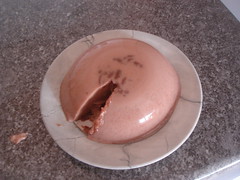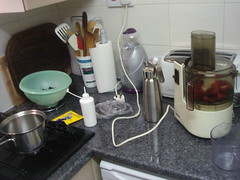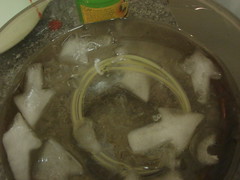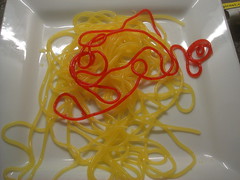2008-03-07
We all remember agar, yes? Using it in petri dishes for growing bacteria? What you may not know is that you can use agar for other things. Edible things. It turns out that it can take the place of gelatin in many recipes, especially jellies. Which is quite handy if you're a vegetarian, unless you like marshmallows, as it doesn't quite work in the same manner. Today's FOODSCIENCE! is all about agar!
The first experiment of the day was to try and recreate the chocolate jelly seen oh-so-briefly on Masterchef a few weeks ago. Nothing special here: melt 100g of chocolate with 300ml of water, mix in some agar and bring to the boil. Remove from the heat and pour into a mould. Leave in the fridge for two hours, and you get this:
It looks much better than it tastes, sadly. I'm guessing that it might have turned out more like it looked on television if I used dark chocolate and a little more agar to make it firmer.
That was just the prelude, though. The real reason that I got the agar was spaghetti. Yes, spaghetti.
It's quite simple. You first make an agar solution in the normal way (I used orange juice and strawberries in two separate batches) and pour it into a squeezy bottle. Then you squeeze the mixture into a series of coiled PVC tubes, placing each one in a bowl of iced water to help the solution set faster.
Now comes the magic! The trusty iSi whipper comes in handy yet again. Charge up the whipper with a canister as usual, and place the tube on the nozzle. Press down, CAREFULLY!, and a noodle of spaghetti will shoot right out. Repeat with the other tubes, then fill them up again for another set of noodles!



